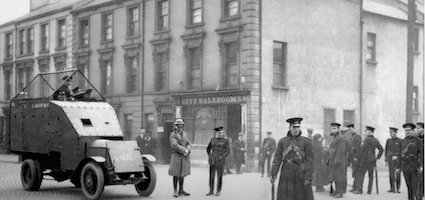Brian Feeney, Antrim: The Irish Revolution, 1912-23 (Four Courts Press, 2021)
Brian Feeney has produced a welcome and valuable account of events in Antrim, with special attention on Belfast, in the tenth and latest volume of the Four Courts Press revolution series.
This book represents essential reading for those interested in the revolutionary period and anyone unfamiliar with the history of northeast Ireland itself. It provides a comprehensive overview of the main events, with particular attention given to the two years of violence in Belfast after the shipyard expulsions of July 1920. Like the other books in the series, Antrim begins with an excellent introduction, which emphasises the county’s uniqueness: "geographically, geologically, politically, economically, religiously and socially." While Andersonstown News readers may all be familiar with such details; the subsequent chapters might provide surprising insights for citizens of the twenty-first-century city.
Ulster Unionist opposition to home rule receives sustained treatment in the first chapter, with Feeney leaving readers in little doubt as to the movement’s top-down character and plutocratic leadership. This ranged from James Craig, with his five mansions around Belfast, to the coterie of aristocrats, millionaire stockbrokers and captains of industry who led the resistance, all "fully aware of what was going on" in terms of armed rebellion.
Similarly, Feeney consistently emphasises the crucial links between Ulster Unionist leaders and the British elite, beginning with his treatment of Bonar Law’s visit to Balmoral in April 1912 that includes reference to the "biggest union jack ever", flying "from a thirty-metre flagpole" - ample evidence, if any were needed, that the loyalist obsession with 'flegs' hardly constitutes a novel phenomenon.
#MSPC Ongoing violence during Truce Excerpt from RO402 chronological listing 452 people killed #Belfast July 1920-August 1922 submitted by Belfast Brigade Committee IRA to Referee Military Service Pensions Act 1934 Note: "P" = Protestant "C" = Catholic @Centenaries @dfarchives pic.twitter.com/MtEIRG7KcR
— Military Service Pensions Collection (MSPC) (@mspcblog) July 26, 2021
While this reviewer made very similar arguments in the Tyrone volume, Feeney’s concentration on high politics gives partition and the Irish revolution’s eventual defeat an air of inevitability that arguably doesn’t fully reflect contemporary conditions: a position he is perfectly entitled to take.
Feeney frequently makes the undoubtedly correct argument that Ulster Unionist leaders formed a component of the very imperial elite who imposed partition, especially in a devastating line regarding the construction of the Unionist regime in the direct aftermath of the summer 1920 pogrom: "For anyone prepared to see it, the evidence was before their eyes."
Nevertheless, his wider point relies on a retrospective fatalism, wherein "neither the IRA in Belfast, the Catholic Church, the nationalist community at large or the Dáil had any effect on unionism in Belfast in 1920-1." All efforts appeared futile against the "inexorable passage of the Government of Ireland bill through Westminster, which was where the fate of northern nationalists was being decided, not on the streets of Belfast."
Arguably, this reading partially relies on Feeney’s characterisation of Unionism as an undifferentiated monolith. On several occasions mid-chapter, this reviewer asked: "where are the Protestants?" as a great deal of the book concentrates on the county’s small nationalist minority rather than investigating its Protestant majority.
While the emergence of a labour opposition to Unionism is dealt with, a more in-depth investigation of the ideology and tensions within the Protestant working class in Belfast and across Antrim between 1918-20 may have produced a more complex picture.
That charge cannot, however, be levelled against Feeney’s nuanced and comprehensive treatment of nationalism, hardly a surprise given his record of research and publication in the area. Some readers may, however, be surprised to learn of the dearth of republican politics in Belfast a century ago, where the "sum total" of activists barely exceeded double digits. He adds: "republicanism in Belfast remained the choice of a tiny minority within the minority".
13/11/20 Londonderry Sentinel reports that 2000 men have applied to join the Ulster Special Constabulary, 662 in Omagh and vicinity. Joe Devlin, Nationalist MP, tells the British parliament the USC will shoot the party's supporters if required. pic.twitter.com/Uh5u4IQn8m
— Six counties centenary (@CentenarySix) November 13, 2020
This partly rested on the ‘charisma’ of Joe Devlin and his brand of Hibernian populism, which helped fill the trenches of the First World War and stuff ballot boxes with votes from the grave, especially when Wee Joe trounced the Sinn Fein president, Eamon de Valera, in West Belfast during the 1918 general election, thereby further reinforcing "the constituencies different character from that of other nationalist districts in urban Ireland."
POLITICAL FIGURE OF STANDING
Feeney also identifies the Sinn Fein party’s failure "to produce a political figure of standing in Belfast, or indeed anywhere else in the north". Indeed, Denis McCullough, the leader of Belfast republicanism, emerges from the pages as a particularly incompetent figure who operated as useful idiot to serious revolutionaries like Clarke and Mac Diarmada in 1916, when he shot himself with the only bullet fired in Ulster during the Rising. He later emerged as the singularly unimpressive "public face" of post-Rising Sinn Féin.
Neither does Feeney shy away from exposing the limitations of the Irish revolution’s national leadership in Dublin, whose position on Ulster was characterised by ignorance, indifference and ineptitude. For instance, it is hard to disagree with his conclusion that "no one in Dublin had paused for a second to consider the effect (in Belfast) of declaring a truce on the eve of the 12th of July, of all days in the year."
Similarly, Feeney has little time for the hagiography that passes for a lot of commentary on Michael Collins, outlining his "calamitous" northern policy as head of the Free State, when the Big Fellow "held the fate of nationalist inhabitants in the northeast of the country in his hands. Almost without exception, he made matters worse for them."
Feeney’s pugnacious and highly readable style only adds to the sense that the Antrim and Belfast IRA appeared ill-equipped to deal with the enormous loyalist forces pitted against the revolution. Indeed, before the influx of Trucileers in July 1921, the IRA had fewer than two hundred men in the city which created the situation where "there were always too many chiefs and too few Indians". Similarly, there "were fewer than 50 active IRA men in North Antrim" in the same period. Neither was the force blessed with effective leaders, many of whom had lived in "cloud cuckoo land since the treaty was signed," while their Unionist opponents swept all before them.
Furthermore, Feeney occasionally employs primary sources to very good effect, particularly in his account of female republican activism, where the Bureau of Military History pension claims help shed light on the role of Cumann na mBan members like Belfast’s Maggie Fitzpatrick or Lena McCamphill and Mary Fitzpatrick in the Glens of Antrim. The retrieval of subaltern female history from what E. P. Thompson famously termed the enormous condescension of posterity constitutes a particular strength of this series.
Feeney’s comprehensive treatment of the Belfast IRA and pogrom owes a significant and understandable debt to the pioneering work of other historians, such as Jimmy McDermott. Above all else, this book provides an, at times, overwhelming blow-by-blow account of the savage reactionary violence unleashed against Belfast’s Catholic community after the pogrom in the summer of 1920 until shortly after the outbreak of the southern civil war almost two years later. The pattern was established in the gory precedent of the 1912 shipyard expulsions, fuelled by "scurrilous, irresponsible rumours", which led to Catholic workers and rotten Prods being "held naked over an open furnace... thrown into a barrel of tar, and several (diving) into the River Lagan to escape being pelted with rivets."
There is not sufficient space here to outline the tragic details of the violence in Belfast during the two-year counter-revolution — as good a reason as any to buy a copy. What emerges is a poignant and painful picture of overwhelming force pitted against a beleaguered minority. Feeney does open the door to a brief counter-factual flight of fancy during the truce, when prior to the remobilisation of the violently partisan Ulster Special Constabulary, the balance of forces permitted an "onslaught from the West Belfast IRA during 29-31 August [1921]," which demonstrated that "training and equipment counted".
Yet LLoyd George slammed this door firmly shut, with his decision to transfer security powers to Craig’s regime, incredibly, during the Treaty negotiations, thereby making the Unionists "masters in their own house". Indeed, Feeney points to the IRA’s eventual descent into sectarian violence in the Belfast cauldron particularly during the carnage of spring 1922, a situation summed up with the telling aside that, by then, "no one could remember who was retaliating for what: it was open season."
Above all, this book provides a concise, intelligible and articulate rendering of events in the only area in Ireland during the revolutionary period where ethnic cleansing and concerted sectarian murder operated as the modus operandi of the predominant military agents – the crown forces and their loyalist allies.
DEADLY ETHNIC RIOTS
Feeney concludes by addressing the historiographical controversy surrounding the term ‘pogrom’ coming down on the side of Brendan O’Leary who argued that the city suffered two years "characterised by pogroms, deadly ethnic riots, intercommunal street fighting, sniping and assassinations."
While this book has significant strengths, this reviewer was left frustrated by the absence of a sustained conclusion and overview, which would have provided readers with an overarching account of the main arguments and analysis.
Neither do I agree with Feeney's contention that it is impossible to gauge the extent to which loyalist violence was orchestrated by Unionist leaders. A sustained treatment of Ulster Unionism and its archives and a refusal to take many of the arguments in the historiography at face value provides ample evidence to make a direct link between pogromist violence and the Unionist elite. Nevertheless, this book has a great deal to recommend it and clearly fulfils the remit of Four Courts revolution series to provide a concise, accessible and scholarly study.






